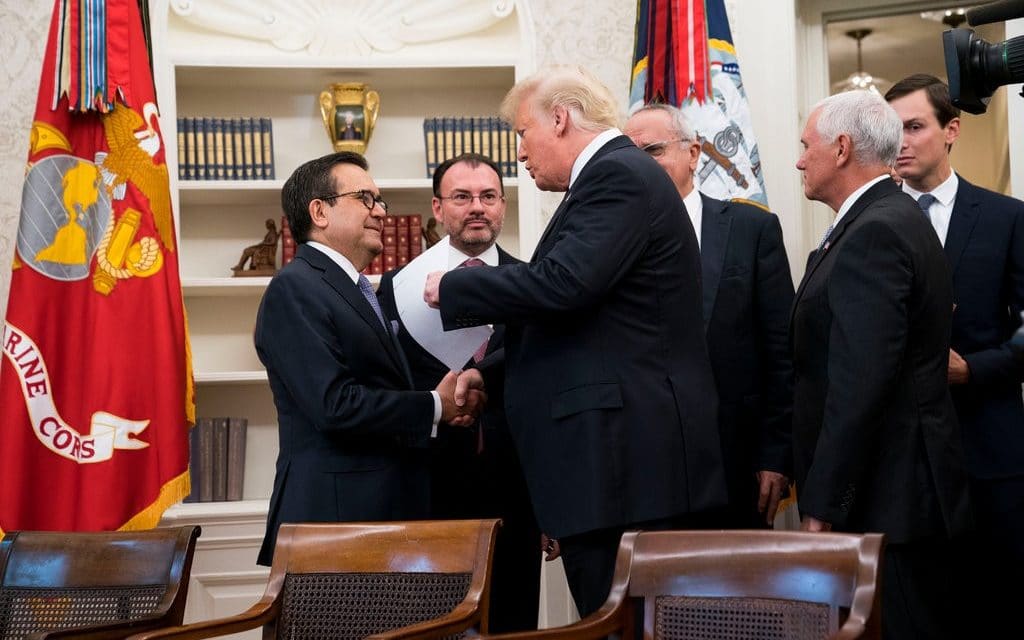Donald Trump announces a trade deal with Mexico — but immediately raises questions about the position of Canada and the future of the North American Free Trade Agreement.
Trump used Twitter to break the news on Monday, after days of intense negotiations between US and Mexican officials: “A big deal looking good with Mexico!”
He followed up with a brief, rambling announcement in the Oval Office:
United States-Mexico Trade Agreement: https://t.co/E1AzveYPli pic.twitter.com/ZYbHt1pD8a
— Donald J. Trump (@realDonaldTrump) August 27, 2018
Trump omitted the Canadians as he said, “They used to call it NAFTA. We’re going to call it the United States-Mexico Trade Agreement.”
Then he threatened 25% auto tariffs on Ottawa if it did not “negotiate fairly”:
One way or another, we have a deal with Canada. It will either be a tariff on cars, or it will be a negotiated deal. A tariff on cars is a much easier way to go. But perhaps the other would be much better for Canada.
Why Trump Won’t Tear Up NAFTA
Trump’s Unrealistic Approach to A Better NAFTA
Mexico’s Version v. US Pressure
Mexican officials presented a much different version of developments, following nine hours of talks on Sunday.
They presented the advance as a revision — not a replacement — of some provisions of NAFTA. These include the amount of input from the NAFTA zone into automobile manufacturing in the US, raising the level from 62.5% to 75%; a requirement that 40% to 45% of the content of vehicles made in North America must come from factories where workers earn at least US$16 an hour; and a 2.5% tariff on output from companies that did not meet the requirement.
Significantly, the Mexicans emphasized the incorporation of Canada into the revised NAFTA without making any threats.
In contrast, the Trump Administration maintained its emphasis on pressure. Trump called Canadian Prime Minister Justin Trudeau, whom he has insulted and who was consigned to a “special section of hell” by Administration officials after June’s G7 summit.
Trump’s chief economic advisor Larry Kudlow said, “It was a good conversation” but then renewed the threat:
We hope Canada is watching carefully at how successful negotiations can go. We really would like a deal with them.
[But] if we can’t get a good strong fair deal with Canada…the U.S. might have to resort to auto tariffs.
Concern and Confusion
Trump’s statement and the US threats threw both Ottawa and Capitol Hill into confusion.
The deal ends NAFTA within 16 years, with a review every six years, unless parties agree to extend the agreement. It does not affect the Trump Administration’s unilateral 25% steel and 10% aluminium tariffs, imposed this spring and used to press for NAFTA’s renegotiation — Canada is the largest exporter of steel to the US.
US Trade Representative Robert Lighthizer also said the agreement with Mexico removes a dispute-resolution clause that has protected Canadian softwood-lumber exports from punitive US tariffs.
Canadian Foreign Minister Chrystia Freeland cut short a European trip to head to Washington on Tuesday.
Freeland asked Lighthizer on Friday if she could come to Washington to meet with him, but was turned down.
“Two senior US officials” said the Trump Administration will proceed with a bilateral trade pact with Mexico if it cannot reach a deal with Canada.
Mexican Foreign Minister Luis Videgaray said he prefers a three-way agreement with Canada, but that Mexico is willing to cut Canada out if necessary: “There will be a free-trade agreement with the United States regardless of whether Canada continues or not.”
Prime Minister Trudeau’s office maintained a positive tone, saying the Trump phone conversation was “constructive”.
But Freeland’s office maintained, “We will only sign a new Nafta that is good for Canada and good for the middle class. Canada’s signature is required.”
And there was support for Ottawa from US legislators and the American manufacturing industry.
NAFTA is a trilateral agreement. It requires legislation and a change to NAFTA requires legislation. I’ve told them any change has to go through Congress. There is not necessarily complete agreement about that.
Senator Lamar Alexander said no one “is envisioning” a revised agreement without Ottawa: “Modernizing it is a good thing, but I hope the president takes whatever agreement he has with Mexico and gets one properly with Canada and we get back to business.”
US manufacturers and businesses pointed to possible disruption of goods and supply chains. Jay Timmons, the president and chief executive of the National Association of Manufacturers, said:
Because of the massive amount of movement of goods between the three countries and the integration of operations which make manufacturing in our country more competitive, it is imperative that a trilateral agreement be inked.
Matthew Shay, the chief executive of the National Retail Federation, echoed:
Coming to terms with Mexico is an encouraging sign, but threatening to pull out of the existing agreement is not. The administration must bring Canada, an essential trading partner, back to the bargaining table and deliver a trilateral deal.

